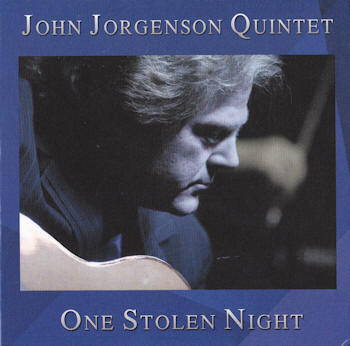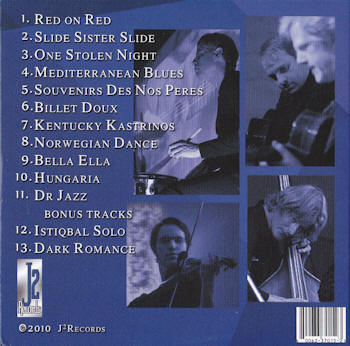
Painting © 2004 Loz
Arkle
Website
© Copyright 2000-2011 Alan White - All
Rights Reserved
Site optimised for Microsoft Internet Explorer



Early Blues Interview
|
|
Alan: What are your first musical memories growing up in Wisconsin, USA? John: I was born in Wisconsin but we moved to California when I was one, so I don’t remember too much from Wisconsin! There was also music around our house because my Mum taught piano lessons at the house and my Dad was a Band Director with the college so we heard music all the time. It was entertainment for us too, it would be a special thing for my sister and I to sit with my Mum and listen to Peter and the Wolf or Carnival of the Animals, so music was always something that was special, or cool or positive. When I was about four, my grandparents gave my sister and I a tiny little phonograph and a set of Disneyland records for Christmas, one of them was the soundtrack to Fantasia which is of course the Nutcracker Suite and I ended up listening to that over and over. My obsession probably started then. Alan: Did you always want to become a musician? John: Yes. It was normal in our house because everybody did music and I always played in orchestras and bands and I liked that but there’s a harrowing audition process that goes along with getting into a really good orchestra when you have to play the same piece as everybody else behind the curtain. I just don’t have that temperament, somebody like Tiger Woods has that kind of temperament but I don’t have it and I always knew that was something I could not do. But when I started seeing rock bands play, I thought that was something I could do. Alan: So what was your first step in getting started? John: I first begged my parents to give me a guitar, but I was already playing the piano and the clarinet by that time and they resisted and were not keen because they wanted me to focus on the other instruments. But I was not going to be denied and eventually I started borrowing guitars from other people and that’s when they realised that it’s not just a fad and he really wants to do this. From that point on, they supported me and I got a guitar, met some other kids around the neighbourhood and we had a garage band. Alan: What kind of material were you playing then? John: That was Santana, Grand Funk RailRoad, Rolling Stones, some Beatles, that kind of rock. Alan: Tell me about how the Hellecasters formed. John: I met Jerry Donohue in the early ‘80s through a mutual friend and thought his playing was fantastic. At that time he was playing in a lounge band with a drum machine and a bass player and a girl singer. This friend, Kittra, took me to see him and I thought, “This guy’s really good” and we became friends. There was a scene around north Hollywood at the time which was kind of country, rocky, punky, king of thing – Dwight Yoakam, The Desert Rose Van, Highway 101, Lucinda Williams, Rosie Flores, Dave Alvin, Los Lobos all came out of that scene. It was a very good time, the early ‘80s in LA and Will Ray was playing with some other bands and I saw him playing and just got his really unique style. We all became friends and, as lead guitar players, we never had time to do anything together. Will had an opportunity to produce an album, a kind of compilation from around the scene that were still bubbling under, and he decided that he wanted one of the tracks to be a guitar extravaganza so he invited me and Jerry Donohue and a friend of ours called Jeff Ross (not the one in our band now, but a different one) and Billy Bremner, so there were five guitarists on this cut and everybody just came in and did a bit. It came out pretty good and so we thought that we should maybe do a live gig. But 5 guitarists is probably too much so we thought we should just have three, and then we needed a name to tell people what it is so I came up with the name. I then said that we shouldn’t just do country and blues jams which is what people are going to expect but let’s do songs. Jerry was American but grew up in England so he was well steeped in the traditions of the Shadows, you know the instrumental melodic guitar music that’s normal for him and that was our plan. We had only planned to do one show, just for fun, and at the end of that show people were coming up to us and saying, “When are you guys playing again? I want to tell my friends about it. You have to do it again”. At the time, I was still in The Desert Rose Van and Jerry was spending at least half his time in Europe and Will was playing in other bands too, so even the ability to do it was difficult. Maybe six months later we did another one. At one of our early gigs, Michael Nesmith from The Monkees was in the audience and he was starting a label at that time and asked us to do an album. Sometimes you set out to put a band together and record an album, but we didn’t. It was just the opposite and it just happened. I feel like it was a really happy accident and we ended up making three albums and a compilation album then we came over to England, Germany and France a few times. The funny thing is that it seems like there’s more interest in the Hellecasters now than there was when we were together. People ask me about it all the time and I say, “Well, that’s great but where was all this interest when we were together?”
John: As a guitarist it would probably have to be a combination between Jeff Beck and Django Reinhardt. Both are really fantastic. In music in general, it was a lot of the classic late 60s British rock people like The Who, Beatles, Stones, Humble Pie, Hendrix, Zeppelin. I learned musical things and recording techniques from everybody, from the Beach Boys, Duane Eddy, Ricky Nelson – I just listed to everything and I like everything. Alan: Are there any particular songs you play which have special meaning to you? John: Yeah, there’s a song called Son Becomes Father and I wrote it at a time period when I was going through that period when you quit being the child and start to take care of your parents as opposed to them taking care of you. He really liked that melody too, so that one does for sure. Alan: Of all the music you’ve written, which is your favourite? John: Maybe Son Becomes Father, some of the gypsy jazz music too. There’s a song I wrote called Black and Blue that is about turning the corner after being single for most of my life and realising that I could get married. My wife loves the song and she had it played whilst she was walking down the aisle at our wedding. Alan: I know you play the mandolin, the mandocello, pedal steel guitar, piano, upright bass, clarinet, bassoon and saxophone. Why did you major the guitar? Was it just the rock ‘n’ roll aspect? John: Probably. I noticed when I was kid that I was always attracted to the sounds of string instruments, not bowed strings but plucked. Early on I loved the sound of the harpsichord, which is basically a pin hitting a string. I remember seeing a movie when I was eight and someone was playing a hammered dulcimer. I didn’t know what it was, neither did my mother but I loved the sound of it. My parents took me to see Christopher Parkening, classical guitarist, and I loved the sound of the blues guitar, electric, country, rock, metal steel, just the strumming of a nice folk guitar, I love all of it. At a young age, there was a social aspect too. I think kids need a place to fit in somewhere and I was not sporty so music gives you a camaraderie. Some of my friends are solo artists, like Tommy Emmanuel, the solo guitarist and I’m a little bit jealous of the ability to do that, but the impracticality of doing it, being by yourself all the time, soundcheck by yourself, loading by yourself, play the gig by yourself. I couldn’t do it. Alan: Which is your favourite guitar? John: My favourite acoustic is probably my first Selmer-Maccaferri, a Django style guitar and very rare and I was very lucky to find one as I think less than 600 were built between 1932 and 1952. I thought it was astronomical at the time but now it’s worth 10 or 15 times what I paid. I also have a Les Paul Junior that I really like to play too, it’s a 1960 and it just has a great sound. I have a lot of guitars and I just like all of them. Alan: I understand that Fender produced two Signature guitars. How did this come about? John: I was a Signature or endorsing artist for G&L which was Leo Fender’s company. He sold Fender, then started Music Man, sold Music Man, then started G&L and maintained that until he died. I worked with Leo Fender on designs there, and then, when he passed away, the company changed hands and the new company’s artist relations department was nearly non-existent, so I was introducing them to other artists but they’d never call them back, and it just got to be not a good business relationship. At the same time, Jerry Donohue was already a Fender artist and he was just campaigning all the time to get Will Ray and I in. Will was a G&L artist too but Jerry wanted to get us over to Fender and he felt that they could probably do something for us if they had the whole group as artists. So, when G&L started not taking care of us so well, then Fender looked more attractive. As I already had a Signature guitar at G&L, I wasn’t going to step down so I thought that if Fender wanted me then they’d have to phone me up, and they did.
They did two, one of which was a limited edition and they did a series of all three Hellecasters’ guitars which they built for a year in 1997. That guitar is called a Fender Hellecaster which is more of a Strad style, a Tremelo. Then their custom shop made me a Signature Hellecaster which is unusual in that it’s a Carina body, the pick-ups are also unusual in that they are humbug pickups but made of Telecaster bobbins. (We’re going to get anorak on this). That is a handmade guitar, very expensive, and they made about two dozen of those between 1998 and 2002. Alan: You were one of the pioneers of the American Gypsy Jazz genre. What originally attracted you to this style of music? John: I was playing Dixieland and Blue Grass music at the time and I didn’t really know much about early jazz so I was learning about it and about some of the players like Eddie Lang. I was playing with a banjo player named Doug Maddox who was a virtuoso banjo player, he could play 5 string, plectrum and tenor, all different tunes and techniques, and he was playing a number of pieces by Harry Reeser and they were show pieces, all t his amazing technique and people would freak out. I said to him I’d heard guitar players from the period but they weren’t like that but there must be some, and he said, “Oh Django Reinhardt”. Too many people had said that same name and I’d read it in guitar magazines with Clarence White saying Django had influenced him, Ged Atkins said Django was the only person he ever asked for an autograph, Charlie Christian used to quote Django’s solos before going into his own and Les Paul copied Django as much as he could, so I knew I had to check out this guy and I bought a record. When I heard the sound, it was electrifying. It was as exciting as Hendrix on electric but on an acoustic. All this technique and the legend of him having only two fingers to use and the whole legend of him rising out of the ashes and the fact that he was the first guy to become famous leading his band. Before that, guitarists were accompanists, even if they had 8 bars here or there as a solo. He was just out front, giving it hell. Because of his handicap and also just because of his creativity. He was trying to make the sound of Armstrong’s trumpet and Duke Ellington’s horn section and all these other sounds on the guitar. So he added all these new techniques to the repertoire and all modern guitar playing goes back to him.
John: When I played with Little Richard, Elton John’s band were backing all these artists for a big show and Little Richard was one of the guests. We were having rehearsals and I remember that some of the artists were coming in for rehearsal and some of them weren’t. We were taking a break and I heard the beginning of what I thought was the record of Good Golly Miss Molly. And then it sounded a little bit different and I turned around to see Little Richard sitting at the piano. Different piano, 30 or 40 years later, but the way he hit the piano, it sounded exactly like the record. I was a huge fan of his and to actually get to play songs with him, was unbelievable. When we’d finish a song, he’d say, “That was gooood. That made my big toe rise up in my boot!” I was a big fan of Rick Nelson too. Not just the 50’s stuff as he was the first guy in mind to do country rock, before the Eagles or Linda Ronstadt he was doing it in the mid 60s. He had Tom Bromley, the pedal-steel player from Buck Owens’ band and Randy Meisner from the Eagles was his bass player. It was really good, very different for the time. When he passed away in the crash, his drummer, Ricky Intveld, was also killed and he was the brother of a good friend of mine. He was named after Rick Nelson; his father was a great fan of Elvis, Jerry Lee Lewis and all the 50s music. I was then hired to do a session and it was for Rick Nelson. They took everything off the tracks except for Rick’s voice and Ricky’s drums and it was really spooky to be sitting there with the headphones hearing Rick Nelson and Ricky on the drums. Before I started Desert Rose Band, I had a band before that called The Cheating Hearts and Steve Duncan was the drummer in Desert Rose Band, The Cheating Hearts and in The Hellecasters. The first time I’d seen him play was with Rick Nelson and the Stone Canyon Band. I was a big fan of Tom Bromley too and after JD Manus left the Desert Rose Band, Tom Bromley came in and played pedal steel for a while. And Sneaky Pete was also steel player in the Cheating Hearts, so there was a kind of a circle.
John: This is my gypsy jazz quintet. My first proper solo album was back in 1987 and I’d been playing Django-style music and Dixieland and Swing back at that time but it was about the time that Desert Rose Band started taking off and I felt that I probably wasn’t going to get a chance to play that kind of music again so I made the album at that time mainly to have a record of what I used to do. As the years went by, I always loved that style of music and I ended up being able to go to France and see it first hand, learn more about it and develop that style and I always wanted to do a follow-up to that first record. So, it’s taken me a long time but I started working on the songs back in 1993 or 1994 and back in 2003 I got a call from a music supervisor asking me if I’d like to recreate two of Django’s tracks for a film. I said, “Yes, I’d love to do that” so I produced some recordings and the Director called me and said “Django makes a particular sort of racket on this guitar and you make the same sort of racket”. He also said they wanted to show Django on screen and I wanted to let him know that I knew a lot about the music but not that I was a crazy psycho Reinhardt fan who had no other life. I didn’t want to scare him away but I said I’ll do whatever, I’ll cut my hair, grow the moustache, whatever. He said, “Great, we’ll have to get the prosthetics department to make you something special for your hand”. I said, “Yeah, that would be great” and he said, “Oh. I was just joking. How could you play?” So I had to say, “Well, I’ve already learned his songs with two fingers”. So with that opportunity, it really kicked me in the ass to finish the album I’d been working on and it was called Franco-American Swing. The interest in Django’s music had grown to the point where there were music festivals, Django-Fests so I got booked for some of those and I started to put a band together to start promoting the album. It went really good and we started touring quite a bit. We’ve done about 100 shows a year for the last 5 or 6 years and I realised that people really liked it when we started doing my own compositions with flavours of other Eastern European, Arabic, Flamenco and other gypsy elements rather than just the straight gypsy swing like Django played and I started featuring those a bit more in the show and that’s how the latest album came about. Alan: I understand you are a patron of the Guitar-X Music School in London. Can you tell me a little about that? John: It’s a school where guys can go and study guitar and learn all kinds of styles, as well as there being a drum division and a vocal division. One of my friends is the Head of Guitar Studies there, John Wheatcroft, and I’ve been to lecture there a few times and I just support the whole idea and curriculum. There was nothing like that when I was learning and I think it would have just been so helpful to have been around other guitarists and other musicians but I felt like I learned in a little void. Alan: What are your current plans? John: I’ve just finished a new album with my quintet, of gyspy jazz, and I think my line up is the best I’ve ever had. I have Kevin Nolan on rhythm guitar (his brother is Robin Nolan who is very well known in gypsy jazz circles.), a bass player from Holland named Simon Planting who is excellent, and a young protégée violin player who has just graduated and is scarily good, and my percussionist is Rick Reed who also plays with Shelby Lynne. We did most of the album live in the studio and it’s a lot of hard-driving swing and I also added the bauzouki. That should be released in January 2010 (see below). I’ve also just finished an album of orchestral music with gypsy guitarists as solo instruments with a full orchestra. It’s called Istiqbal , which is a Romany word meaning “welcoming in the future”. To my knowledge this has not been done like this before with new music specifically written for this. One of my father’s dreams was for me to play more with orchestras so I think he might be pulling some strings from the other side! I’d love to do more with an orchestra and bring in the energy of the guitar. I hadn’t thought of it before but it’s probably got something to do with the classical Russian music I like too. Alan: Thank you very much John. It’s been wonderful meeting you and I really appreciate your time. _________________________________________________________________________
Albums available from John's website: Return to Blues Interviews List
Website, Photos © Copyright 2000-2010 Alan
White. All Rights Reserved. |





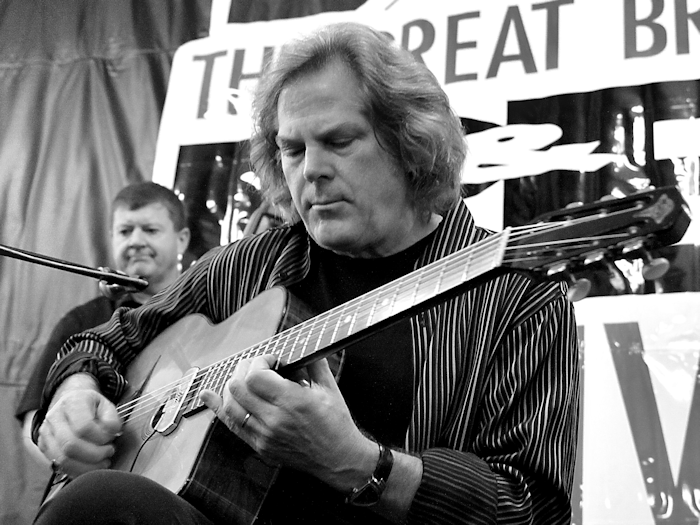
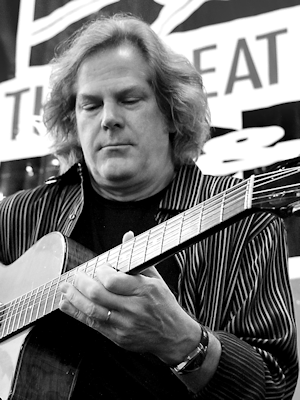 Alan:
Who has influenced you the most in your music?
Alan:
Who has influenced you the most in your music?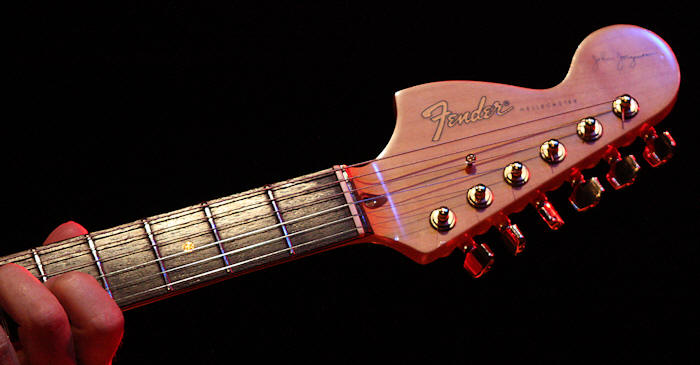
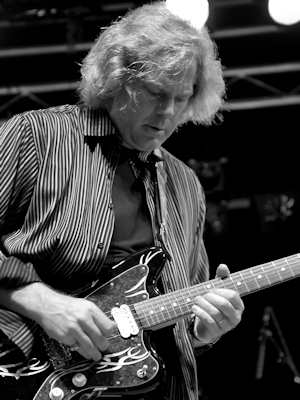 Alan: You played with an amazingly diverse range of artists, Elton
John, Bob Dylan, Bob Segar, Rob Orbison, Johnny Cash, Benny Goodman,
Sting, it goes on and on; even Pavarotti. You must have memories you
cherish.
Alan: You played with an amazingly diverse range of artists, Elton
John, Bob Dylan, Bob Segar, Rob Orbison, Johnny Cash, Benny Goodman,
Sting, it goes on and on; even Pavarotti. You must have memories you
cherish. Alan:
Tell me about the making of your latest album, Ultraspontane.
Alan:
Tell me about the making of your latest album, Ultraspontane.